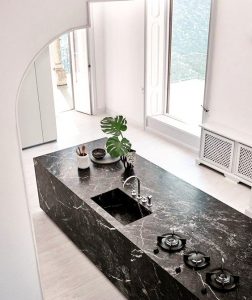
Granite has become one of the most popular natural stones used in new homes and renovated kitchens. That is, especially thanks to its wide variety of colours and patterns. It is often turned into kitchen and bathroom vanity countertops, backsplashes, fireplace mantels, desktops, and sometimes even floor tiles. The amazing antibacterial properties of granite make it perfect for bathroom and kitchen surfaces.
However, as with every natural stone, granite is durable, yet porous. This is why it is important that you get proper installation and regular maintenance. That way you will ensure your granite surfaces will keep their good looks for longer. The key to proper cleaning and maintenance is using the correct products and methods. Fortunately for you, most of the ingredients you need can be found in your kitchen cupboards or pantry.
Most installed granite is sealed by the professionals that installed it. Resealing is only needed every 2-4 years (depending on how often you use the surface). This will keep its glossy finish and prevent hard-to-remove stains from setting in the stone. Resealing should be done by professionals so if you think it is time, do not hesitate to call the company that installed your granite.
According to professional cleaners, granite countertops in the kitchen should be cleaned after each use to remove food residue, spills, splatters, and other grime. Granite surfaces in the bathroom should only be wiped after every use and thoroughly cleaned once a week. Most desktops and mantles only require weekly dusting. However, countertops and granite floors should be dusted and wiped daily and cleaned with dishwashing liquid and water solution once a week (depending on the amount of use).
Cleaning your granite daily
Kitchen and bathroom granite countertops need daily attention to prevent stains and protect their sealant. Granite floors should also be dusted and wiped daily. Do not use any harsh cleaning products, such as ammonia, bleach, foaming bathroom cleaners, or scrubbing powders on granite surfaces. They may damage the natural stone. Another thing to avoid is using acidic products such as lemon juice or vinegar. They will dull the granite finish over time.
1. Wipe spills as they happen – Always wipe any spills as soon as they happen. Acidic products like ketchup or pickles can damage the finish of the granite.
2. Mix a cleaning solution – Mix a solution of warm water and dishwashing liquid. For easy application, put it in a spray bottle.
3. Spray and wipe – Spritz countertops, then use a microfiber cloth to wipe them. Do not forget the underside. Allow the surface to air dry.
4. Sweep or dust granite floors – Granite floors need to be vacuumed, swept, or dusted daily. That way you will remove dirt and loose soil that may scratch the surface.
Cleaning grease and stains from granite surfaces
Even if cleaned daily, granite countertops can become greasy or sticky over time. You may also notice some stains (those will need extra care).
1. Remove greasy film – To clean countertops and backsplashes near kitchen stoves and cooking areas, mix a 1:1 solution of cool water and rubbing alcohol. Pour it into a spray bottle, spritz the surface and wipe with a microfiber cloth. Allow to air dry.
2. For tough stains – In a small bowl, mix baking soda and hydrogen peroxide (this should form a thick paste with the consistency of peanut butter). Spread the paste over the stained area and place plastic wrap on top. Allow it to sit there for 24 hours. Then remove the plastic wrap, allow the paste to completely dry and wipe away. This will help you remove tough stains like red wine or coloured drinks. Repeat until the stain is gone if needed.
3. Restore the shine – If your granite is looking a little dull, you can restore its shine until the next resealing. Apply a few drops of vegetable oil on a microfiber cloth and apply it to the granite surface. Use another cloth to buff it. Do not use this method on granite floors – they may become slippery and cause falling.
Extra tips on how to maintain your granite surfaces in good condition:
• Always use a cutting board. Avoid cutting directly on the granite countertop since this may cause scratches and marks.
• Avoid drastic temperature changes. Use trivets when placing extremely hot or cold pots or utensils. This is especially important for slow cookers and instant pots that will expose your granite to excessive heat for long periods of time.
• Do not use your granite surfaces as a seat or a step (when reaching a top cupboard for example). Excessive weight in one spot of the granite may cause cracks or other damage. Grab a chair instead.
• Avoid placing acidic foods and products directly on the granite surface. Use a plate or a cutting board instead. Half a lemon placed on your granite countertop may leave marks and dull the finish of the stone.